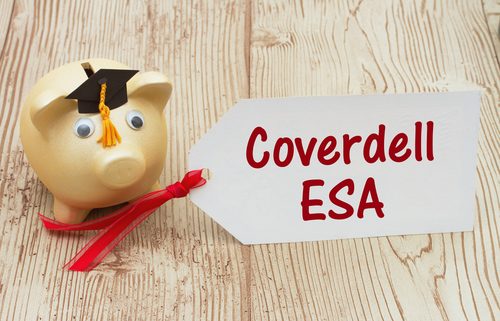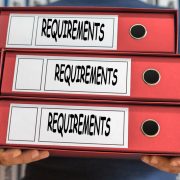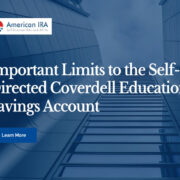Coverdells Allow for Self-Directed IRA style Investing for College Savings
These days, lots of people understand that IRAs allow taxpayers to self-direct their investments – taking more direct control of their investments and allowing them more flexibility to diversify and avoid high expense ratios and assets-under-management fees commonly charged by Wall Street firms and mutual fund companies.
Not too many people realize that you can do the same thing within a Self-Directed Coverdell Education Savings Account (CESA) as well.
Recent changes to the tax code allow taxpayers to use Section 529 plans to cover elementary and secondary school expenses on a tax-advantaged basis – but at present, Section 529 plans do not allow you to use self-directed techniques to invest your family’s college savings.
Section 529s have much higher limits, but they also restrict your investment choices to whatever funds have been approved by state 529 plan administrators.
The deadline for Self-Directed CESA contributions for tax year 2018 is April 15th, 2019.
About Self-Directed CESAs
A Coverdell education savings account (Coverdell ESA) is a trust or custodial account set up in the United States solely for paying qualified education expenses for the designated beneficiary of the account. There are certain requirements to set up a Self-Directed CESA:
- When you establish the account, the designated beneficiary must be under the age of 18 or be a special needs beneficiary.
- You must make the designation of the account as a Self-Directed Coverdell CESA when you create it.
- The document creating and governing the account must be in writing, and it must meet certain requirements.
You can read more details about Self-Directed Coverdell CESAs in IRS Publication 971 – Tax Benefits for Education.
Advantages of Self-Directed CESAs
Self-Directed CESAs allow you to look beyond state-approved mutual funds for investment opportunities. Using a Self-Directed CESA, you can invest your college savings money in real estate, stocks,bonds, mutual funds, closely-held companies, venture capital, gold and precious metals, investment real estate near a college, partnerships, LLCs, farms and ranches and much more.
The account owner can transfer the assets to the benefit of any eligible family member under the age of 30.
Contributions are made with after-tax dollars. That is, there is no first-year deduction available for Self-Directed CESAs. However, investments within the Coverdell ESA grow tax-deferred, and withdrawals to pay qualified educational expenses are tax-free.
For Self-Directed CESAs, qualified educational expenses for college and post-secondary school include tuition, fees, books, supplies, equipment, and (if enrolled on at least a half-time basis) room and board.
For younger kids – elementary and high-school aged students – qualified educational expenses include tuition, fees, academic tutoring, special needs services,books, supplies, equipment, room and board, uniforms, transportation, computer equipment, software and internet access.
Disadvantages of Self-Directed CESAs
Self-Directed CESA contributions are capped at $2,000 per year – including Self-Directed CESA contributions.
If you are filing as a single taxpayer, your modified adjusted gross income(MAGI) must be less than $110,000 to qualify to contribute to a Coverdell ESA. For married couples filing a joint return, the MAGI limit is $220,000.
A trust or corporation can also make contributions to a Coverdell on an eligible student’s behalf but trusts and corporations cannot own IRAs.
Note: The income limits do not apply to organizations making ESA contributions. So,if your personal income exceeds the MAGI limits for Coverdells, you may be able to make a ‘back door’ contribution via a trust or corporation you control, or use a Section 529 plan, which has much more generous income limits.
Coverdell Success Story
Sarah started a Self-Directed CESA when her son was born 16 years ago,expecting to use it to fund college. Her investments within the Coverdell ESA did very well. As it turned out, her son had some special needs, and needed to attend a specialized middle school and high school. There were no good public education resources nearby, so she needed to enroll him in a private school.College enrollment is unlikely due to the nature of her son’s condition.
Her Self-Directed CESA account saved her thousands in taxes, since she was able to use tax free distributions from her Coverdell ESA to cover most of her son’s educational expenses.
Interested in learning more about Self-Directed IRAs? Contact American IRA, LLC at 866-7500-IRA (472) for a free consultation. Download our free guides or visit us online at www.AmericanIRA.com.






